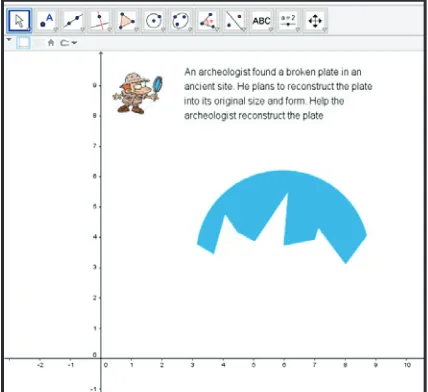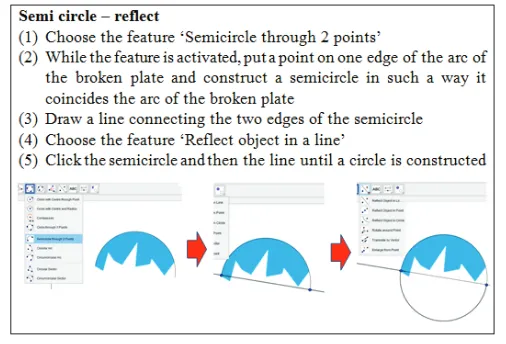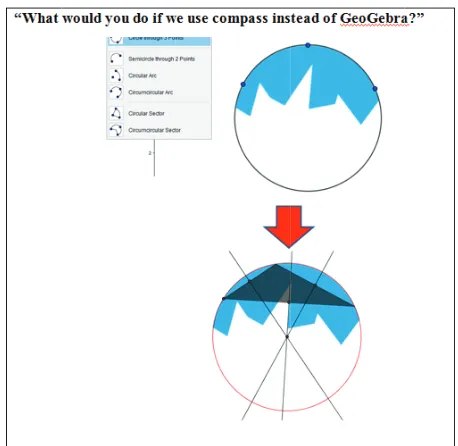Exploring students’ modeling competences: A case of a GeoGebra-based modeling
task
Ariyadi Wijaya
Citation: AIP Conference Proceedings 1848, 040008 (2017); doi: 10.1063/1.4983946 View online: http://dx.doi.org/10.1063/1.4983946
Exploring Students’ Modeling Competences: A Case of a
Geogebra-based Modeling Task
Ariyadi Wijaya
1, a)1Mathematics Education Department - Yogyakarta State University
Jurdik Matematika FMIPA UNY, Kampus Karangmalang, Jl. Colombo No.1 Yogyakarta 55281, Indonesia
a)Corresponding author: [email protected]
Abstract. This study was aimed to explore undergraduate students’ modeling competences. A total of 36 undergraduate students were involved in the study. These students worked in groups to solve a modeling task which was presented in GeoGebra application. The students’ modeling competence was investigated before and after the use of metacognitive instruction. The study shows that the students could make a mathematical model or mathematical question of the modeling task. However, prior to the use of metacognitive prompt the students mainly focused on exploring the features of GeoGebra application rather than on identifying mathematical strategies. After the use of metacognitive prompt, the students shifted from feature-based strategies to mathematical strategies. The results of this study indicate that metacognitive prompt is helpful to direct students to think about mathematical concepts or strategies which are relevant to a modeling task.
INTRODUCTION
Students’ ability to apply mathematics has long been considered as an important goal of mathematics education in many countries including Indonesia [1], [2]. Indonesian national curriculum has long been considering this ability. In the early 2000, the competence-based curriculum (Kurikulum Berbasis Kompetensi – KBK) and the school-based curriculum (Kurikulum Tingkat Satuan Pendidikan – KTSP) considered that the subject of mathematics is aimed to develop students’ ability to: (1) understand the concepts of mathematics, explain the relevance of concepts, and apply the concepts or algorithms in a flexible way in problem-solving; (2) solve problems that require the ability to understand a problem, design and complete a mathematical model to solve it, and interpret the solution; and (3) appreciate the purpose of mathematics in life [3]. This educational goal is also considered in the Curriculum 2013 in which the Indonesian government mandates that education must be relevant to the needs of life and offers students opportunities to apply their knowledge in society [4].
Teaching tasks which require mathematical modeling should emphasize on guiding students to actively and independently identify the relevant mathematics concepts by using their prior knowledge and experiences [7]. To conduct such teaching approach, a teacher needs to keep a balance between guiding students and encouraging students to work independently. For this purpose, metacognitive prompts are potential to elicit students to reflect on their own understanding of the problem and on their modeling process. This paper describes how metacognitive questions could bring students from the first level of modeling competence to the second and third of modeling competence.
Modeling Process and Modeling Competences
According to Blum [7], modeling process comprises seven steps. The first step is making a ‘situation model’ to understand the real-world problem. The second is developing the situation model into a ‘real model’. The third step is mathematizing the real model to construct a ‘mathematical model’. Fourth, the solvers carry out mathematical procedures to obtain a mathematical solution. The fifth step is interpreting the mathematical solution in terms of the real-world problem. The sixth step is validating the real-world solution and, finally, presenting the real-world solution. These seven steps can be simplified into four main stages, i.e. comprehending real-world problems; transforming the real-world problems into mathematical problems; carrying out mathematical procedures; and encoding or interpreting solution [9].
Students’ understanding and skills to do modeling process is called as ‘modeling competence’. Modeling competences can be defined by specifying sub-competences that are related to students’ understanding of modeling process [10]. These competences comprise:
a. Competences to understand a real-world problem and to construct a real model based, which include: - ability to simplify the real-world situation;
- ability to identify key variables;
- ability to construct relations between the variables;
- ability to look for available information and to differentiate between relevant and irrelevant information;
b. Competences to construct a mathematical model, which include: - ability to mathematize relevant variables and their relations; - ability to simplify relevant variables;
- ability to choose appropriate mathematical concepts or strategies;
c. Competences to solve mathematical problems within the mathematical model, which include: - ability to use mathematical procedures;
- ability to use mathematical knowledge to solve the mathematical problem; d. Competences to interpret mathematical results in a real situation, which include:
- ability to interpret mathematical results in terms of the real-world situations; - ability to generalize solutions that are developed for a special situation; - ability to communicate about the solutions;
e. Competences to validate the solution, which includes:
- ability to critically check and reflect on the obtained solutions;
- ability to review the modelling process if the solutions do not fit the situation; - ability to reflect on other strategies of solving the problem;
Metacognitive Prompt
similarities/differences between this problem and the problems you have ever solved?”. The third type is strategic questions that ask students to reflect on appropriate strategies for solving the problems; e.g. “What kind of strategies which are appropriate to solve the problem?” The last type of question is reflection questions that focus on the modeling processes and the obtained solution; “Did I do something wrong?”; “Does the solution make sense?” Appropriate questioning can be used: to direct students to think on relevant mathematics concepts; to help students extend their thinking from concrete and factual knowledge to analytical and evaluative aspect; to help students find connections between different mathematics concepts or between mathematics and real-world contexts [13]. Another kind of self-questioning is in the form of “what if” questions. According to Kaur [14], a “what if” task with a modified information or form could lead students to re-think the task and see the impact of the changes of the task on the solution process. Furthermore, a “what if” questioning could direct students to explore appropriate mathematics concepts or strategies.
Another type of metacognitive prompt is self-instruction that is given in the form of a verbal prompt or instruction to help students focus attention on particular aspects of the solving process and to assist them in carrying out the solving process [11]. For example, the instruction to underline the important information in a task can be used to guide students to focus on identifying relevant information. Asking students to paraphrase a task is also an important prompt. According to Kletzien [15], explaining in students’ own words where the task is about, makes them, while doing this, get a better understanding of the task.
METHOD
Participants of this study were 32 first year undergraduate students who were enrolled in a mathematics education study program. In other words, these students were prospective secondary mathematics teachers. These students worked in groups to solve a task situated in a real-world context. The task was about reconstructing a broken plate into its original size and form. The task was presented in GeoGebra environment (see Figure 1) so that students could use GeoGebra’s features to solve the task. It was expected that the features of GeoGebra could encourage students to do mathematical exploration or discovery learning and stimulates students to personalize their creations through exploration of features. The teacher guided students’ works by giving metacognitive questions.
FIGURE 1. A real-world mathematics problem presented in GeoGebra environment
RESULTS AND DISCUSSION
mathematically about constructing a complete circle which is coincident with the broken plate. Although the students started to think about mathematical ideas, it seemed that they have not fully constructed a mathematical model. None of the students mentioned the center of circle in relation to constructing a circle. It indicates that the students focused on the shape of a circle and did not really consider the mathematical properties and mathematical construction of a circle.
After the students knew what the task was about, they started to solve the task. The task was presented in GeoGebra environment which meant the features of GeoGebra connect to mathematics concepts. However, the students’ works show that the students only focused on the features of GeoGebra technically and did not really consider mathematics concepts related to the features they used. For example, students who used the feature ‘Circle through three points’ (see Figure 2) could not give mathematical explanation how a circle could be constructed from three given points. Another students’ improper strategy in constructing a full circle is shown on Figure 3.
FIGURE 2. Students’ feature-based strategy: ‘Circle through three points’
FIGURE 3. Students’ feature-based strategy: ‘semi circle – reflect’
mathematical characteristics or properties of a circle. At this point, students’ competence is about making a real model on the basis of the real-world task. However, after the use of “what if” metacognitive question, the students could identify mathematical characteristics which were related to the task. Finally, the “what if” question helped students develop their competence to make mathematical model and to solve the mathematical model. Another interesting finding is that the students could shift from the first level of competence to the second and third level independently. This finding confirms Blum’s [8] argument that metacognitive prompt could keep a balance between teachers’ guidance and students’ independence works.
REFERENCES
1. Eurydice, Mathematics education in Europe: Common challenges and national policies (Brussels: Education, Audiovisual and Culture Executive Agency, 2011).
2. National Council of Teachers of Mathematics, Principles and standard for school mathematics, (Reston: NCTM, 2000).
3. Pusat Kurikulum, Kurikulum 2004. Standar kompetensi mata pelajaran matematika Sekolah Menengah Pertama dan Madrasah Tsanawiyah [The curriculum 2004: The competence standards for mathematics in Junior High School and Islamic Junior High School], (Jakarta: Departemen Pendidikan Nasional, 2003). 4. Kementerian Pendidikan dan Kebudayaan, Dokumen Kurikulum 2013 [The document of the Curriculum 2013]
(Jakarta: Kemdikbud, 2012).
5. J. De Lange, “Mathematics for literacy,” in Quantitative Literacy: Why numeracy matters for schools and colleges, edited by B. L. Madison & L. A. Steen. (Princeton, NJ: National Council on Education and Disciplines, 2003), (pp. 75–89).
6. OECD, The PISA 2003 Assessment Framework - Mathematics, Reading, Science, and Problem Solving Knowledge and Skills (Paris: OECD, 2003).
7. W. Blum, “Can modelling be taught and learnt? Some answers from empirical research”, in Trends in teaching and learning of mathematical modelling edited by G. Kaiser, W. Blum, R. B. Ferri & G. Stillman (New York: Springer, 2011), pp. 15–30.
8. B. Greer, “Modelling reality in mathematics classrooms: The case of word problems,” Learning and Instruction, vo. 7, no. 4, pp. 293–307, 1997.
9. A. Wijaya, M. van den Heuvel-Panhuizen, M. Doorman, and A. Robitzsch, “Difficulties in solving context-based PISA mathematics tasks: An analysis of students’ errors,” The Mathematics Enthusiast, vol. 11, no. 3, pp. 555-584, 2014.
10. K. Maass, “What are modeling competencies?,” ZDM – The International Journal on Mathematics Education,
vol. 38, no. 2, pp. 113 – 142, 2006.
11. M. Montague, “Self-regulation and mathematics instruction,” Learning Disabilities Research and Practice, vol. 22, no. 1, pp. 75–83, 2007.
12. B. Kramarski, Z. R. Mevarech, and M. Arami. “The effects of metacognitive instruction on solving mathematical authentic tasks,” Educational Studies in Mathematics, vol. 49, no. 2, pp. 225–250, 2002.
13. M. Swan and D. Pead, Professional development resources. Bowland Maths Key Stage 3, Bowland Charitable Trust (2008). Retrieved from http://www.bowlandmaths.org.uk on 3 September 2016.
14. B. Kaur, “Some “What” strategies that advance reasoning and communication in primary mathematics classroom”, in Reasoning, communication, and connections in mathematics edited by B. Kaur and T. T. Lam (Singapore: World Scientific, 2012), pp. 75 – 88.


